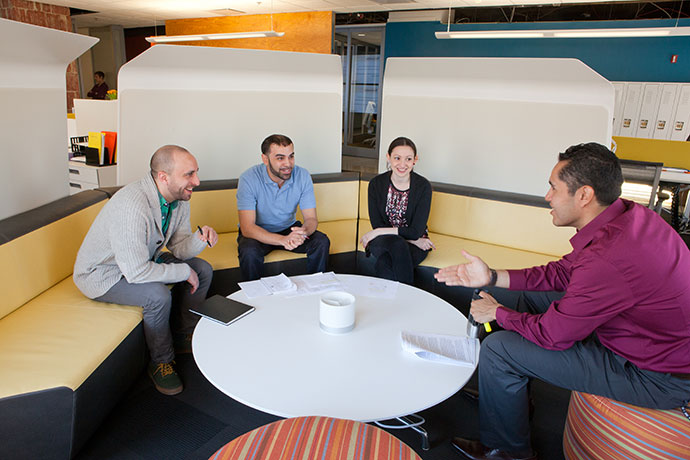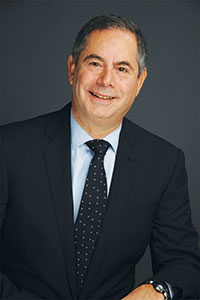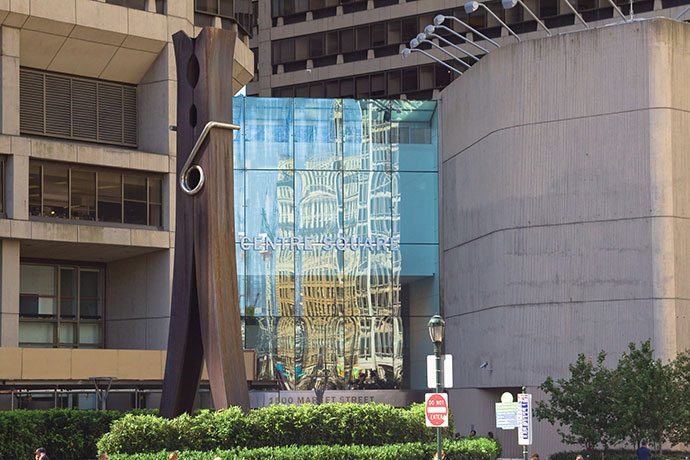The lease is not yet signed. But that’s not preventing Public Health Management Corp. of Philadelphia from shouting from the rooftops about its pending headquarters move and the open space concept the nonprofit is embracing in the very center of the city.
Designed to encourage collaboration and innovation, the new space at 1500 Market St. at the landmark Centre Square development, across from Philadelphia’s City Hall and the forthcoming Dilworth Plaza, will occupy approximately 125,000 sq. ft. (11,612 sq. m.) on five floors of the building, once home to Comcast and CoreStates office personnel.
“With the new space, we have taken cutting-edge ideas that work in the business world and applied them to the nonprofit environment,” said Richard Cohen, CEO of PHMC, in announcing last month the pending move from its current Atlantic Building address on South Broad St. “The design reflects the way people work today and encourages a culture of collaboration, creativity and efficiency. The new environment will transform the way we work in a way that no other nonprofit in the region has done before.”
Since its inception in 1972, PHMC has served the Greater Philadelphia region as a facilitator, developer, intermediary, manager, advocate and innovator in the field of public health. It even reaches well beyond the region with such efforts as its affiliate National Nursing Centers Consortium. With 1,700 employees, the organization’s combined annual impact on the Philadelphia community’s economic vitality is estimated to be in the range of $500 million, which includes $75 million paid to PHMC and affiliate employees, $46 million paid to those living in the City of Philadelphia and $2 million in total wage taxes paid to the City of Philadelphia through PHMC and affiliate salaries.

Collaborative meeting space for impromptu brainstorming meetings will be a hallmark of PHMC’s new workspace. Approximately 25 percent of the new PHMC offices will be dedicated to shared workspaces and amenities.
PHMC’s business has increased to approximately $175 million, with 350 programs addressing every variety of public health need, from crime and safety to AIDS prevention to food security, Medicare to healthcare work-force skills development. The roster of programs even includes a new Center for Data Innovation launched last month, whose full-scale health research firm services will be offered to the corporate and nonprofit sectors alike.
PHMC says the new space will not only meet its increased capacity needs, but also meet the changing workspace needs of its employees. Results of a recent PHMC survey revealed that employees spend 41 percent of their time working with others, and 50 percent of employees are losing at least one hour every day due to workplace issues, such as distractions in or around the work area, access to technology, finding co-workers and finding an appropriate meeting space.
Open the Doors … or Simply Remove Them
To address these issues, PHMC partnered with architecture and workspace design firm Bradberry & Kheradi, Steelcase and Corporate Interiors to create a dynamic work environment that integrates design with culture change. The new space will include an open floor plan allowing for easy access to coworkers and cutting-edge technology for increased mobility and collaboration. Twenty-five percent of the space will be dedicated to shared work spaces and amenities, including lounge areas, impromptu meeting space, support services and the PHMC “Town Square” featuring a café and fitness center.

Richard Cohen is CEO of Public Health Management Corp.
The nearly 1.8-million-sq.-ft. (167,220-sq.-m.), two-building Centre Square development was constructed in the early 1990s. A leasing contact at CommonWealth REIT, owner of Centre Square, declined to comment about the PHMC deal because of the pending nature of the lease, and referred the inquiry to Dave Campoli, vice president of the REIT’s Eastern division. But Campoli was out of town traveling all week and unavailable for comment.
Cohen, however, more than makes up for it with his voluble enthusiasm for the project. In an interview this month, he says the organization’s imminent lease expiration was a motivation to rethink its existing space or test the market.
“We did both of those things at essentially the same time,” he says. Possibilities included renewing the lease, leasing somewhere else or buying the Broad St. building out of bankruptcy (Post Bros. ended up doing that, and is redeveloping the property as apartments). But the strategic thinking, says Cohen, was larger in scope.
“Really it was, ‘Who are we? What’s the vision? Who do we want to be?’ he says.
The project management, planning and design firm led by Nancy Bradberry and Sandy Kheradi, which first worked with PHMC 20 years ago on its current offices in the city and at locations around the region, was key in helping to answer those questions.
“They know our business and our sensibilities,” says Cohen. “We started talking about what an office of the future looks like for us.”
It was more than an exercise: PHMC was also in the midst of a cultural transformation toward a more “aggressive, hungrier, business-like” approach that involved a new governance and board structure and the creation of an early retirement plan.
“I’ve been here 33 years and I was essentially ‘the boy,’ ” Cohen says. Some people moved on, and as PHMC made new hiring decisions based on talent, it also started investigating how a new physical office environment might mesh with the structural changes of the organization. Cohen, who led the expeditions, went with his team to New York City and other locations, visiting cutting-edge office space from e-commerce and digital firms, which tended toward a more open, even industrial feel. The new GlaxoSmithKline headquarters at Philadelphia’s Navy Yard also offered a model.
“It isn’t just an office, but a new model.“
— Richard Cohen, CEO, PHMC
“They’re along a continuum, from no closed offices to a lot of them,” he says of the many venues his team has visited. “As we looked more and more, we began to think of how open we wanted to be. Some of what we do has HIPAA issues, but everyone who works here has the same constraints — you can listen to what someone else is saying, just not [if you’re] from outside.”
Insights from the furniture makers and workspace designers helped the PHMC team evaluate collaborative vs. personal space, the height of partitions, its café and its “town center” concept. As Cohen explains it, the idea is to encourage people to bring their laptops, find forms, find pension information all in a downtown-like area, with little “shops” that cater to their needs. “Everyone goes through this town square,” he says.
Cohen says Steelcase, through its local distributor Corporate Interiors, was chosen as the furniture vendor because of its industrial, forward-thinking and international orientation, as well as an “incredibly service-oriented” approach that took PHMC’s senior team through workshops as it sought to weave together the threads of culture change and workspace design.
Take Me to the Pilot
But where was this revolutionary workspace going to be placed? Cohen says he didn’t want a traditional search driven by the real estate broker.
“We said, ‘We’re going to look, we know what’s out there.’ People regularly brought ideas to us. But generally we found most of our ideas ourselves. We were making the best possible decision for us, without it being driven by other agendas.
“I was called most of the names in the book by people in the industry,” he continues. “I was told I didn’t know what I was doing. Very late in the process, one of those people we’d never met before brought something to us. We weren’t necessarily believing it was going to be for us, but the more we looked and negotiated, the more it was for us.”
While the lease remains unsigned as of this date, Cohen says the process is “very far along.” He says other big-name prospects also had looked at the property, but when it came down to negotiations with the landlord, “they were hungry and we were hungry” to make the deal work.
“About 75 or 80 percent of staff right now are in offices. Going forward it will be five to 10 percent. Six hundred employees in open space will be a huge change.“
— Nancy Bradberry
The PHMC offices will be the first fully open-architecture offices in the building. And their implementation is being facilitated by PHMC taking another cue from GlaxoSmithKline: Constructing “at a significant cost” a pilot space in PHMC’s existing headquarters, in order to acclimate staff to what it will feel like in the new workspace, from collaborative meeting space to workstations to monitor-laden walls — “kind of like a mini-Comcast,” says Cohen, referencing that company’s HQ lobby in the city. PHMC has hosted a dozen or so groups of 50 each over several days in the pilot space, bringing in the new food vendor, more or less making an event out of the orientation process, and gathering reams of useful feedback on everything from the walls to the size of the furniture.
At the same time, PHMC has continued to manage its culture shift, acclimating senior leaders and other thought leaders across the PHMC spectrum — including social workers, nurses and doctors and young people — to being “ambassadors of change” in both the ways and means of getting things done.
Cohen says the work involved a lot of teambuilding, as well as primers on open workspace etiquette.
“About 75 or 80 percent of staff right now are in offices,” says Nancy Bradberry. “Going forward it will be five to 10 percent. Six hundred employees in open space will be a huge change.”
Daylight and Energy
The change includes staff education on work habits, such as noise levels and conversation, personal space protocol and visual manners (i.e. not putting up political posters). Bradberry says the increased team approach will be cultivated by what she calls the best part of the new layout: “It will be a brighter, lighter, more energizing space,” she says. And the energy from more daylight comes at the same time PHMC is implementing more transparency and openness in terms of supervisor/staff relations, so that each can feel more comfortable about approaching the other.

Taken from the Centre Square development where PHMC’s HQ will soon be located, this view shows what’s in store as Dilworth Plaza takes shape in the heart of downtown Philadelphia. The new Dilworth Plaza will be professionally managed, maintained, and programmed by the Center City District, and will serve as a gateway to regional transit that welcomes 305,000 passengers into Center City each day. It will connect the Broad Street entrance of the Pennsylvania Convention Center to the Avenue of the Arts, linking the office district to Market East shopping and hotels. The $55-million transformation of Dilworth Plaza on the west side of City Hall, begun in January 2012, will be completed in 2014.
Photo by Peter Tobia courtesy of Center City District
There are still private rooms for work needing quiet focus or confidentiality, but interactive, “drop-in” spaces will now be the norm.
“The whole space is being designed for a mobile employee, who can take a laptop and choose where they want to work,” says Bradberry, whose firm’s work has shepherded similar transformations at large companies. “It took a lot of calibration to get the sound masking to the right levels,” she says of one past project. But PHMC is a different animal, and it’s a different generation too.
“They’re more willing to work as a team and in an unusual environment,” Bradberry observes. “It’s a generational thing.” As for the open office, she says, “One of the things we find is they tend to have respect for each other and dress nicer. It brings an energy to the staff. It also tends to help when they need to recruit. If they see a tired old space with old furniture, they’re not going to be as charged up.”
Bradberry says the unsigned lease hasn’t limited progress, and the firm is just about finished with construction drawings it’s been working toward for the past four months.
“The client has encouraged us to move forward even without the lease being signed,” she explains. “They have to be out of the space they’re in, and they want to be. It’s like a kid in a candy store — you see what you’re going to have and you can’t wait to move. The building is a good one for them. Not only did Richard Cohen get an incredible deal, but it’s centrally located to a lot of the city agencies, with City Hall right across the street, and mass transit on the lowest level of the building. Employees seem to be quite happy with the choice. The commute is a lot easier than what they could have had had they chosen another building.”
“It isn’t just an office, but a new model,” says Cohen, for how a not-for-profit serving populations across the life span “can start to bring about change in the communities we care about.” The professional atmosphere, he says, makes people think they’re in a doctor’s office, not a Medicaid office. “You wouldn’t know that 90 percent of our focus in our programs is on people at enormous risk. We’re deeply involved in serving the hardest-to-reach and hardest-to-serve people. We have two new buildings for adolescents in treatment and for the elderly, and have the largest community health database in the country. All of this is driving us. The important thing is that we interconnect all of these things.”
Whether it’s seatbelt use, tobacco use prevention or a child suffering from developmental delay or behavioral issues, “How do we wrap those services around people?” Cohen asks. “We want the offices to emulate that same kind of ‘wrapping’ of people, to attain the common good collaboratively.”
If it sounds like Cohen’s all in, he admits it.
“We’ve drunk the Kool-Aid,” he says, “and I’m a full-grown CEO. It’s a legacy issue, it’s going to make all the difference in the world, and I believe in it completely.”
